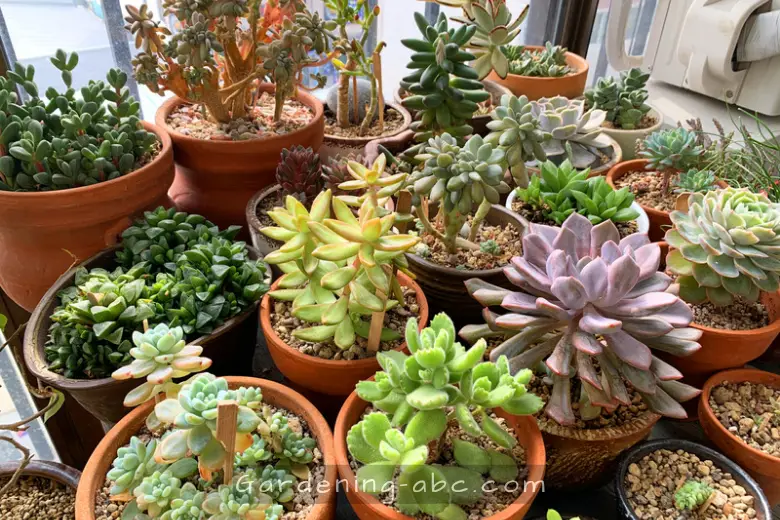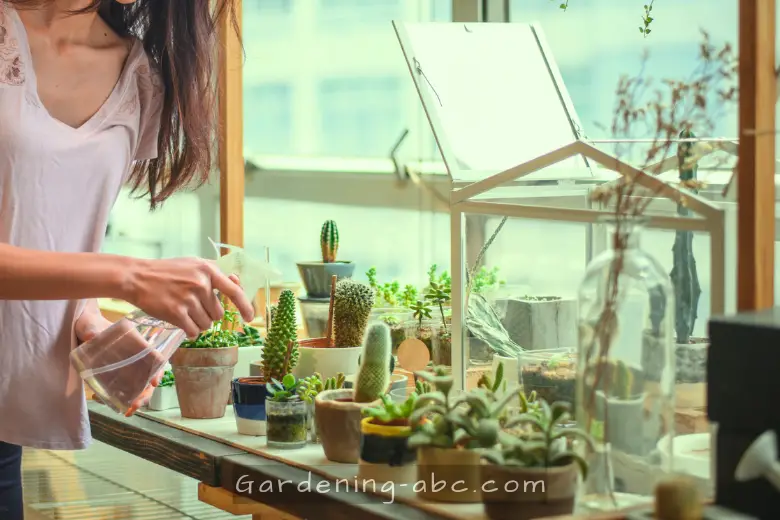We use affiliate links to run our site. When you buy through links on our site, we may earn an affiliate commission, without any added cost to you. Learn more
Succulents are popular houseplants because they are easy to care for and come in a variety of shapes and colors. However, one of the most common questions that succulent owners have is how often to water them.
Unlike other plants, succulents store water in their leaves, stems, or roots, and can survive in dry conditions for a long time.
Overwatering can cause root rot, fungal infections, and leaf drop, which can kill your succulent. On the other hand, underwatering can cause your succulent to shrivel, lose color, and stop growing. So how do you find the right balance?
The answer is not as simple as following a fixed schedule or measuring the amount of water you give your succulent. There are many factors that affect how often your succulent needs water, such as the type of succulent, the size of the pot, the type of soil, the climate, and the season.
In this blog post, we will explain how to consider these factors and how to check if your succulent needs water or not.
Understanding Succulent Care Basics
Before we dive into the watering schedule for succulents, let’s first review the basics of succulent care. Succulents are a diverse group of plants that come in various shapes and sizes.
They are native to arid regions and have adapted to survive in harsh conditions, making them an ideal choice for indoor and outdoor gardening.
Here are a few things to keep in mind when caring for succulents:
- Soil: Succulents prefer well-draining soil that is not too dense or compact. A mixture of perlite, sand, and potting soil works well for most succulents.
- Light: Succulents need plenty of bright, indirect sunlight to thrive. However, too much direct sunlight can scorch their leaves and cause them to turn brown or black.
- Temperature: Succulents are generally tolerant of a wide range of temperatures, but they prefer warmer climates. They can withstand occasional frost, but prolonged exposure to cold temperatures can damage their leaves and stems.
- Water: Succulents do not require frequent watering like other houseplants. Overwatering can be harmful to succulents, as they are susceptible to root rot.
Now that we have reviewed the basics of succulent care, let’s talk about watering succulents.
The importance of watering succulents
Watering your succulent is essential to its overall health and well-being. Like all plants, succulents need water to survive. However, because succulents store water in their leaves, stems, and roots, they do not need to be watered as often as other plants.
Overwatering your succulent can lead to root rot, which is a fungal disease that can kill your plant. Underwatering, on the other hand, can cause your succulent to become dehydrated and can lead to stunted growth and discoloration.
So, finding the right balance of water for your succulent is crucial.
Factors to consider when watering succulents
Now that you understand the importance of watering your succulent let’s take a closer look at some factors to consider when watering your plant.
Type of succulent
Succulents are a diverse group of plants that belong to different families and genera. Some succulents can store more water than others, and some succulents can tolerate more drought than others.

For example, cacti are succulents that can go for weeks or even months without water, while echeverias are succulents that need more frequent watering.
Therefore, it is important to know what kind of succulent you have and research its specific watering needs.
Size of the pot
The size of the pot affects how quickly the soil dries out and how much room the roots have to grow. Generally, smaller pots dry out faster than larger pots and shallow pots dry out faster than deep pots.
Therefore, succulents in smaller or shallower pots need more frequent watering than succulents in larger or deeper pots.
However, you should also avoid using pots that are too large for your succulent, as this can cause the soil to stay wet for too long and increase the risk of root rot.
The ideal pot size for your succulent is one that is slightly larger than the root ball and has drainage holes at the bottom.
Type of soil
The type of soil affects how well it retains or drains water. Succulents prefer well-draining soil that does not hold too much moisture and allows air to circulate around the roots.
You can use a commercial potting mix designed for cacti and succulents, or you can make your own by mixing regular potting soil with perlite, sand, or gravel.
You should avoid using soil that is too rich in organic matter or clay, as this can cause waterlogging and suffocation of the roots.
Climate
The climate affects how much water evaporates from the soil and the plant. Succulents are native to arid or semi-arid regions where they have adapted to low humidity and high temperatures.
However, if you live in a humid or cold area, your succulent may need less water than usual, as the air is already moist and the plant does not lose as much water through transpiration.
Conversely, if you live in a dry or hot area, your succulent may need more water than usual, as the air is dry and the plant loses more water through transpiration.
Season
The season affects how much light and heat your succulent receives and how fast it grows. Succulents have different growth cycles depending on their origin and type.
Some succulents grow actively in summer and go dormant in winter, while others grow actively in winter and go dormant in summer. During their active growth period, succulents need more water than during their dormant period, as they use more energy for photosynthesis and cell division.
You can tell if your succulent is dormant or not by observing its appearance and behavior. A dormant succulent may stop producing new leaves or flowers, lose some color, or drop some leaves.
The Best Watering Schedule for Succulents
Succulents have unique watering needs, and there is no one-size-fits-all watering schedule for all types of succulents. The frequency of watering will depend on several factors, such as the type of succulent, the size of the pot, the climate, and the season.
Here are some general guidelines to follow:
- Watering Frequency: As a general rule of thumb, water succulents once a week during the growing season (spring and summer) and once every two to three weeks during the dormant season (fall and winter). However, this may vary depending on the type of succulent and the conditions it is growing.
- Watering Amount: When watering succulents, it is important to give them enough water to soak the soil thoroughly. Allow the soil to dry out completely before watering again. Avoid watering too frequently, as this can lead to overwatering and root rot.
- Testing Soil Moisture: To determine whether your succulent needs water, stick your finger about an inch into the soil. If the soil feels dry, it is time to water. If it still feels moist, wait a few more days before checking again.
- Climate and Season: Succulents require less water in cooler and less humid conditions. During the summer months, you may need to water your succulents more frequently to account for the increased evaporation.
How to water succulents:
Follow these steps to ensure you are giving your plant the right amount of water:
- Use well-draining soil: Succulents do not like sitting in wet soil, so it’s important to use well-draining soil. You can buy a pre-made succulent soil mix or create your own by mixing sand, perlite, and potting soil.
- Water thoroughly: When it’s time to water your succulent, be sure to water it thoroughly. Water the soil until it is completely saturated and water begins to drain out of the bottom of the pot.
- Allow the soil to dry completely: After watering, allow the soil to dry completely before watering again. This will prevent overwatering and ensure your plant stays healthy.
- Avoid getting water on the leaves: Succulent leaves are prone to rotting, so it’s important to avoid getting water on them. Water directly into the soil around the plant.
- Water less in the winter: During the winter months, succulents go into a period of dormancy and require less water. Be sure to adjust your watering schedule accordingly.
Signs of overwatering and underwatering:
Knowing the signs of overwatering and underwatering is essential for keeping your succulent healthy. Here are some signs to look out for:
Signs of overwatering:
- Mushy, soft leaves
- Yellowing leaves
- Brown or black spots on the leaves
- Foul odor coming from the soil
Signs of underwatering:
- Wrinkled leaves
- Dry, crispy leaves
- Slow or stunted growth
- Discoloration of leaves
If you notice any of these signs, adjust your watering schedule accordingly.
Tips and Tricks for Succulent Care
In addition to following the proper watering schedule for your succulents, there are a few other things you can do to ensure they stay healthy and thriving:
- Choose the Right Pot: Succulents prefer pots with drainage holes that allow excess water to drain out. Avoid pots with saucers that trap water, as this can lead to overwatering.
- Use the Right Soil: As mentioned earlier, succulents prefer well-draining soil that is not too dense or compact. A mixture of perlite, sand, and potting soil works well for most succulents. Avoid using regular potting soil, which can retain too much moisture and cause root rot.
- Avoid Overcrowding: Succulents need plenty of room to grow and spread out their roots. Avoid overcrowding them in small pots, as this can lead to stunted growth and root rot. Here is how big a succulent can really grow.
- Prune Regularly: Regular pruning can help keep your succulents healthy and promote new growth. Remove any dead or yellowing leaves, and trim back overgrown stems as needed.
- Keep an Eye Out for Pests: Succulents are susceptible to pests such as mealybugs, spider mites, and scale insects. Inspect your plants regularly for signs of infestation, such as yellowing leaves or sticky residue on the leaves. If you notice any pests, treat your plants with an organic insecticide or insecticidal soap.
Final Thoughts:
Understanding the unique watering needs of your succulents is key to keeping them healthy and thriving. By following the tips and tricks outlined in this article, you can ensure that your plants get the right amount of water and avoid common issues like overwatering and root rot.
We hope that this comprehensive guide has been helpful to you in your succulent care journey. If you found this article useful, please share it with your friends and family who also love succulents. And be sure to explore more articles on this site for more helpful tips and tricks on plant care.
Remember, caring for succulents is a fun and rewarding hobby that can bring joy and beauty to your space. So take action today and start implementing these tips to keep your succulents healthy and thriving for years to come!
Amazon and the Amazon logo are trademarks of Amazon.com, Inc, or its affiliates.

Hi there! My name is Prasenjit and I’m an avid gardener and someone who has grown a passion for growing plants. From my hands-on experience, I have learned what works and what doesn’t. Here I share everything I have learned.
